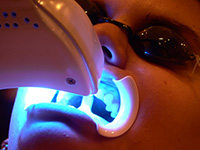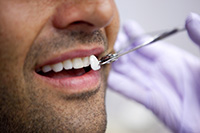
 If you've been looking for ways to makeover your smile, you might find the treatment options a little overwhelming. A smile makeover can be as simple as a slight cosmetic tweak, or as involved as a full mouth reconstruction. Two of the more popular treatments involved in smile makeover are teeth whitening and veneers. Both treatments have their share of benefits, but which is right for you?
If you've been looking for ways to makeover your smile, you might find the treatment options a little overwhelming. A smile makeover can be as simple as a slight cosmetic tweak, or as involved as a full mouth reconstruction. Two of the more popular treatments involved in smile makeover are teeth whitening and veneers. Both treatments have their share of benefits, but which is right for you?
How They Work
Teeth whitening is a commonly performed cosmetic dentistry treatment that involves applications of a bleaching agent (hydrogen peroxide or carbamide peroxide) to whiten the teeth. Also commonly called tooth bleaching, the treatment specifically targets tooth discoloration by removing staining and reversing the effects of routine wear.
Although the best whitening results are most often achieved when performed by a dentist, there are a wide range of do-it-yourself teeth whitening options available (dentist prescribed and over the counter). Basic over-the-counter whitening options have the lowest concentration of peroxide, limiting their whitening strength.
The treatment procedure varies depending on the specific whitening option you select. In-office whitening generally takes one hour or less, during which a bleaching gel is applied to the surface of the teeth for one or more periods of 15 to 30 minutes. A high-intensity light may be used to help speed up the process. Patients will see whitened results immediately after treatment.
Although results are immediate, teeth whitening is not a permanent solution to discoloration. Dentists often prescribe take-home trays designed to maximize the effect and prolong results. In addition, certain foods and drinks should be avoided.
 Dental veneers are tooth-colored shells of porcelain or composite placed over the top of the facial surfaces of the teeth to correct worn tooth enamel, uneven alignment or spacing issues, discoloration, chips or cracks. Veneer placement requires the permanent alteration or "shaping" of the host tooth/teeth. (Minimal preparation veneers offer an alternative to traditional veneers in that they require less preparation of the natural teeth; however they too are more invasive than whitening.)
Dental veneers are tooth-colored shells of porcelain or composite placed over the top of the facial surfaces of the teeth to correct worn tooth enamel, uneven alignment or spacing issues, discoloration, chips or cracks. Veneer placement requires the permanent alteration or "shaping" of the host tooth/teeth. (Minimal preparation veneers offer an alternative to traditional veneers in that they require less preparation of the natural teeth; however they too are more invasive than whitening.)
The veneer procedure varies from case to case, but is typically completed over a six week period and two dental visits each of which can last several hours. The initial visit involves a diagnostic evaluation to ensure that there are no oral health concerns that may affect treatment, in addition to selecting veneer color from a shade chart. Some dentists use outside labs for veneer fabrication, while others use in-office CAD/CAM technology to fabricate onsite in a single visit. Depending on your dentist, temporary veneers may be used between visits.
During the actual procedure appointment, a local anesthetic is administered to minimize discomfort. After placement your dentist will speak with you about how best to maximize the longevity of your veneers. This includes avoiding overly abrasive toothpastes and biting down on hard objects. If treated properly, veneers can last 15 years or longer before needing replaced.
 Are you a Candidate?
Are you a Candidate?
is a minimally invasive procedure that does not have strict candidacy requirements. That said whitening isn't right for everyone. Poor dental hygiene can inhibit whitening treatment. If you suffer from gum disease or tooth decay, you will first need to undergo corrective treatment before teeth whitening can be considered. Application of bleaching agents to unhealthy teeth could result in extreme pain. If you have deep tooth staining (intrinsic staining) affecting the underlying dentin layers, you may not be able to achieve the results you're looking for with bleaching. Whitening cannot correct all discoloration issues (such as those associated with tetracycline). In such cases, additional smile makeover treatments such as veneers will likely be needed.
Dental veneer candidacy relies heavily on the health of the smile. If you have no underlying problems such as decay or gum disease, you stand a better chance of qualifying for veneer treatment. However, you might be surprised to hear your dentist advise against veneers; or at the very least suggest alternatives. Your dentist will always suggest the most conservative, minimally invasive option as a primary consideration. Oftentimes, people request veneers, even though they have an esthetically functional, attractive smile. If your issue is simply tooth discoloration, a dental veneer option may not be the best treatment for you. It requires the permanent alteration of your natural teeth, and can be considerably more expensive than whitening options that may suffice.









